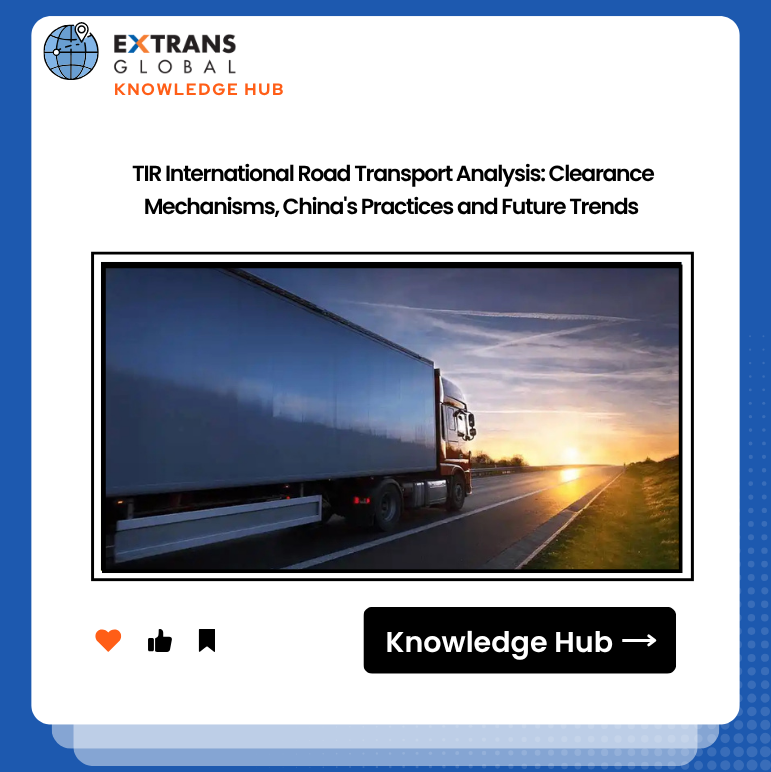TIR International Road Transport Analysis: Clearance Mechanisms, China's Practices and Future Trends

Introduction:Against the backdrop of global supply chain restructuring, TIR international road transport is emerging as a new artery for Eurasian trade, leveraging its unique advantage of "one permit for cross-border clearance". Taking Linyi's practices in China as a case study, this article systematically dissects TIR's operational mechanisms, economic benefits and future challenges, providing practical guidance for cross-border logistics practitioners.
一.Core Concepts and Global System of TIR Transport
TIR (Transports Internationaux Routiers) refers to the international road transport system, a global cross-border transport convention led by the United Nations Economic Commission for Europe (UNECE), enabling "one-time declaration, direct delivery" through standardized customs clearance processes. Its core advantages include:
- Customs Clearance Convenience: With a TIR Carnet, goods can be exempt from unpacking inspection among signatory states, reducing border waiting time from 2-3 days in traditional port transshipment to within 4 hours;
- Global Network Coverage: As of 2025, over 70 countries have joined the TIR Convention, forming a road transport network centered on Eurasia and extending to Africa.
二.Comparison of TIR with Other Cross-Border Transport Modes
|
Transport Mode |
Transit Time (Linyi to Almaty) |
Cost Index |
Application Scenarios |
|
TIR Road Transport |
5 days |
★★★☆☆ |
Application Scenarios |
|
Railway Transport |
20-25 days |
★★★★☆ |
Bulk goods (ores, agricultural products) |
|
Sea + Land Transport |
20-25 days |
★★★★☆ |
Bulk goods (ores, agricultural products) |
三.Technology and Operational Processes of TIR Transport
1. Core Technical Support
- Electronic Seal System: Records cargo information via RFID chips, enabling full-track traceability with financial-grade tamper-proof capabilities;
- GPS Tracking Monitoring: Transport vehicles are mandated to install real-time positioning devices, allowing customs of signatory states to verify route compliance online.
2. Standard Operational Process:

Taking the Linyi-Almaty route as an example: In the TIR transportation from Linyi to Almaty, the goods are declared at Linyi Port in one go and an electronic TIR certificate is applied for. When passing through the border of Kazakhstan, there is no need to open the box again, and the customs clearance can be directly completed with the electronic TIR certificate.
四.Strategic Layout and Innovative Practices of Linyi's TIR Network
1. Route Coverage and Network Effects
- Operational Routes: 5 main routes to Russia, Kyrgyzstan, Uzbekistan, Belarus and Kazakhstan have been opened;
- Future Plans: After obtaining GMS (Greater Mekong Subregion) approval in 2025, 5 new routes to Southeast Asian countries including Vietnam and Thailand will be added, forming a "Central Asia-Southeast Asia" cross corridor.
2. Technological Practices for Efficiency Enhancement
- Multimodal Transport Integration: Linyi Port collaborates with Qingdao Port to achieve seamless transfer of "TIR road + sea transport", reducing comprehensive costs by 20% compared to traditional models;
- Digital Customs Clearance: Using 5G+AI intelligent document review systems, TIR Carnet processing time has been shortened from 4 hours to 15 minutes.
五.Regional Economic Empowerment Logic of TIR Transport
1.Enterprise-Level Value
- Typical Case: A building materials enterprise exporting tiles to Kazakhstan via TIR reduced transport cycles from 25 days to 5 days, improving order response speed by 80% and acquiring 15% of the Central Asian market;
- Cost Structure Optimization: Door-to-door transport saves 30% in intermediate link costs compared to traditional "land transport + separate customs declaration".
2.Industrial Ecology Upgrading
- Factor Agglomeration Effect: Attracting leading international logistics enterprises like DHL and Cainiao to establish regional headquarters, driving the clustered development of supporting industries such as cross-border e-commerce and supply chain finance;
- Industrial Closed-Loop Construction: Linyi's small commodities exported via TIR routes have driven a 20% increase in local manufacturing capacity, forming a virtuous cycle of "logistics-trade-manufacturing".
六.Future Trends and Challenges of TIR Transport
1. Technological Upgrading Directions
- Intelligent Breakthrough: Linyi will pilot L4-level autonomous driving TIR trucks in 2026, enabling unmanned transport at the China-Kazakhstan border and reducing labor costs by 40%;
- Green Transition: The EU plans to implement new standards in 2027 requiring TIR vehicles to reduce carbon emissions by 50%, promoting large-scale application of hydrogen fuel trucks in cross-border transport.
2. Potential Challenges
- Geopolitical Risks: Customs clearance efficiency fluctuates in some Central Asian countries, requiring process standardization through "Belt and Road" multilateral cooperation mechanisms;
- SME Access Threshold: High initial investment in TIR systems requires policy support (e.g., Linyi provides 10% freight subsidies to enterprises using TIR routes).
七.TIR Transport Glossary
- TIR Carnet: International road transport permit, equivalent to a "cargo passport", applicable in over 120 countries;
- TIR Transport Unit: Sealed containers or trucks complying with UNECE standards to ensure goods are not illegally unpacked during transport;
- GMS-TIR Linkage: Docking of the Greater Mekong Subregion with the TIR system, enabling "one-time customs clearance" for Southeast Asia-Central Asia cross-border transport.
Conclusion:Linyi's TIR network practices not only exemplify Chinese logistics enterprises' participation in global rule-setting but also highlight the strategic value of road transport in the "Belt and Road" initiative. With technological innovation and network expansion, the TIR model is poised to become the "road version of the Silk Road" connecting Eurasia, providing more flexible and efficient solutions for global supply chains and driving cross-border logistics from "infrastructure connectivity" to deep-level "rule and standard mutual recognition".

top



